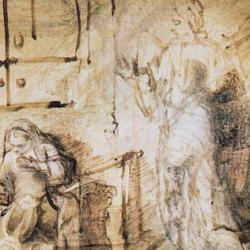I expressed some disagreements and some commendations for Seth Postell’s Adam as Israel a few days ago. Here I sum up some more of Postell’s insights.
1) He takes the description of the serpent in 3:1 as a positive description: He is “more prudent” (Heb. ‘arom) than all the beasts. that contrasts to the eventual judgment on the serpent, “more cursed than all the creatures of the field” (3:14). Postell observes, “God did not make a ‘crafty’ creature; he made a wise creature” (123). If so, then the fall of Genesis 3 isn’t merely the fall of man but the fall of the serpent. That is exactly right.
2) He offers this lengthy quotation Christophe Nihan’s From Priestly Torah to Pentateuch, about the chiastic symmetry of the Pentateuch: “On the level of content, it was to be noted that there are several parallels between the books of Genesis and Deuteronomy on the one hand and of Exodus and Numbers on the other; obviously, these four books were intended by the Torah’s editors to form a twofold frame around Leviticus. Genesis and Deuteronomy are both closed by a blessing of the 12 tribes (Gen 49//Deut 33) followed by the death of the main character who pronounced the blessing (Jacob and Moses respectively) and a notice of his burial (Gen 50; Deut 34). Besides, the parallel between Jacob and Moses is further highlighted by a series of devices. Exodus and Numbers similarly exemplify several parallels, particularly in the section on the wilderness wanderings and the rebellions of the Israelites, which stands at the center of both compositions. Further, although the wilderness sojourn in Numbers is considerably more developed, virtually all the elements of the wilderness wandering of Exodus have a parallel in Numbers 20-21. The two sections also share some unique language, such as the motifs of the community’s ‘murmurs’ against Moses and Yahweh . . . , the accusations addressed to Moses of letting the community die in the desert . . . , the nostalgia for Egypt expressed by the Israelites. . . . There are also obvious parallels between the so-called ‘legal’ sections of the two books” (quoted 143-4).
Postell shores up this point by noting parallels between the story of fall and exile from Eden and the prophecy of exile in the final chapters of Deuteronomy, which form a “pessimistic” inclusio around the Pentateuch (136-8). He also spells out the parallels between Jacob and Moses, and their structural role in the organization of the Pentateuch (145-7). In Postell’s view, Jacob and Moses embody the future-oriented faith of Israel: Both men must look beyond the exile, knowing full well that God’s purposes for his people will come to fruition in ‘the last days,'” a hope focused on the coming of a conquering king from Judah (Genesis 49:8-12; Deuteronomy 33:7), a king who will fulfill the promise at the beginning of the Pentateuch (Genesis 3:15).
3) In his final chapter, Postell explores how Genesis 1-3 introduces not only the themes of the Pentateuch, but the aims of the Tanakh as a whole. In one part of his analysis, he notes the links between the “seams” of the canon – the opening of Joshua (Former Prophets) and of the Psalms (which open the Writings). Psalms 1-2 speak of a wise man who studies Torah day and night, a king who conquers the raging nations. These Psalms are glosses on Joshua 1:8, where Joshua is commanded to keep the Torah before him as he goes out to conquer the Canaanites (152-3). We can thus line up the Seed promise of Genesis 3 that opens the Pentateuch with Joshua and the opening Psalms.
4) Another aspect of Postell’s analysis of the canon is an examination of the shape of Chronicles, the final book of the Hebrew canon. He quotes Hendrik Koorevaar at length: “The books that precede Chronicles start with Genesis and end with Ezra-Nehemiah. By also starting with Adam and ending with Cyrus’s edict, the Chronicler picks up introductorily the beginning of the first book of the canon (Genesis) and concludes with the beginning of the last book of the canon (Ezra-Nehemiah). Thereby it is expressed that he overviews the entire preceding Old Testament, and is thinking from that perspective. . . . Israel is rooted to the world in the beginning of the book, into humanity, in Adam with his mandate to rule over the whole world. At the end of the book, Israel is finally weaved into all the kingdoms of the earth, over which YHWH has given Cyrus dominion. . . . The history of Israel is fixed between the non-Israelite and universal ruler, Adam, and the non-Israelite and world ruler, Cyrus. Such a frame makes it clear that Chronicles did not pursue the goal of understanding Israel with its Davidic king and its temple as the final goal; rather both are understood as the center. Israel as the people of Yahweh, with David and the Temple, has a function of universal significance, all of humanity is its horizon” (quoted 160-1).
That’s essentially the premise of my work on Chronicles, due to be published sometime in 2019.











